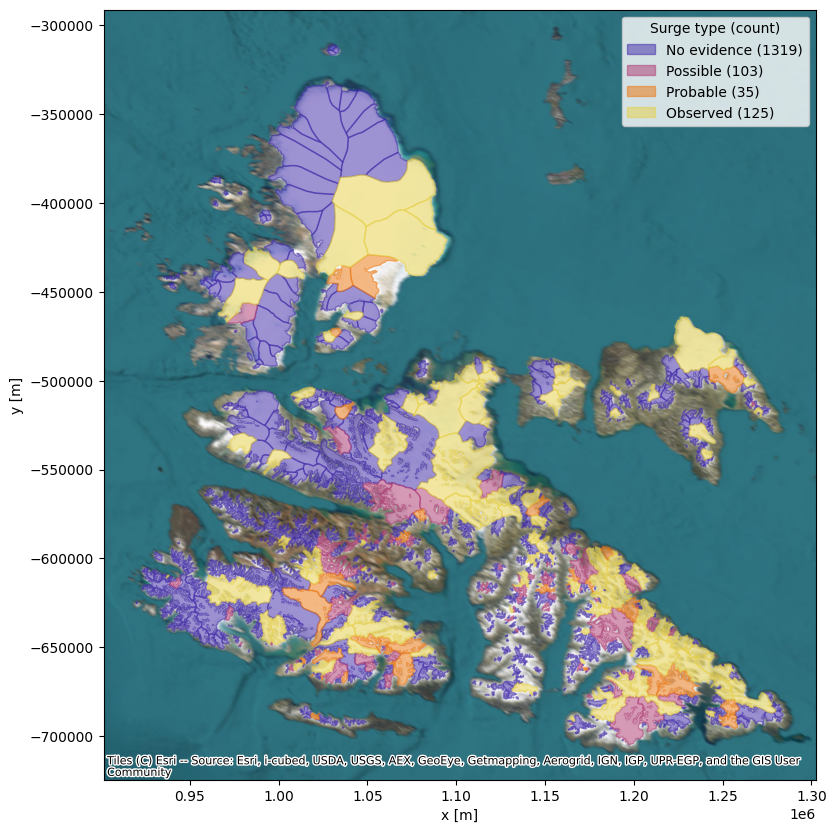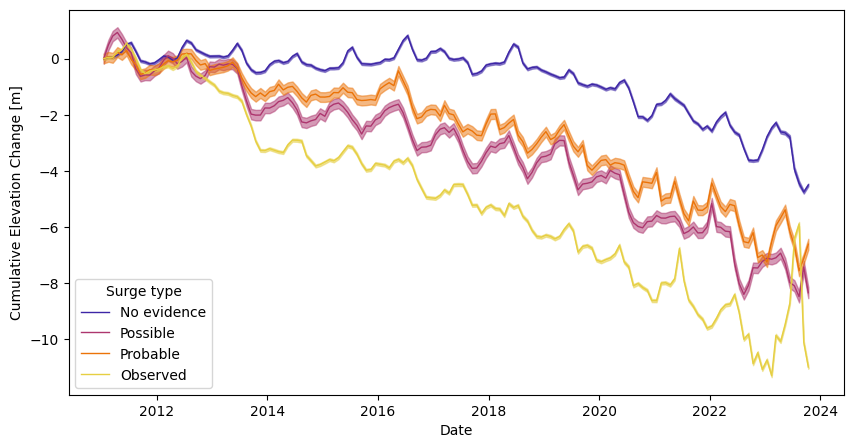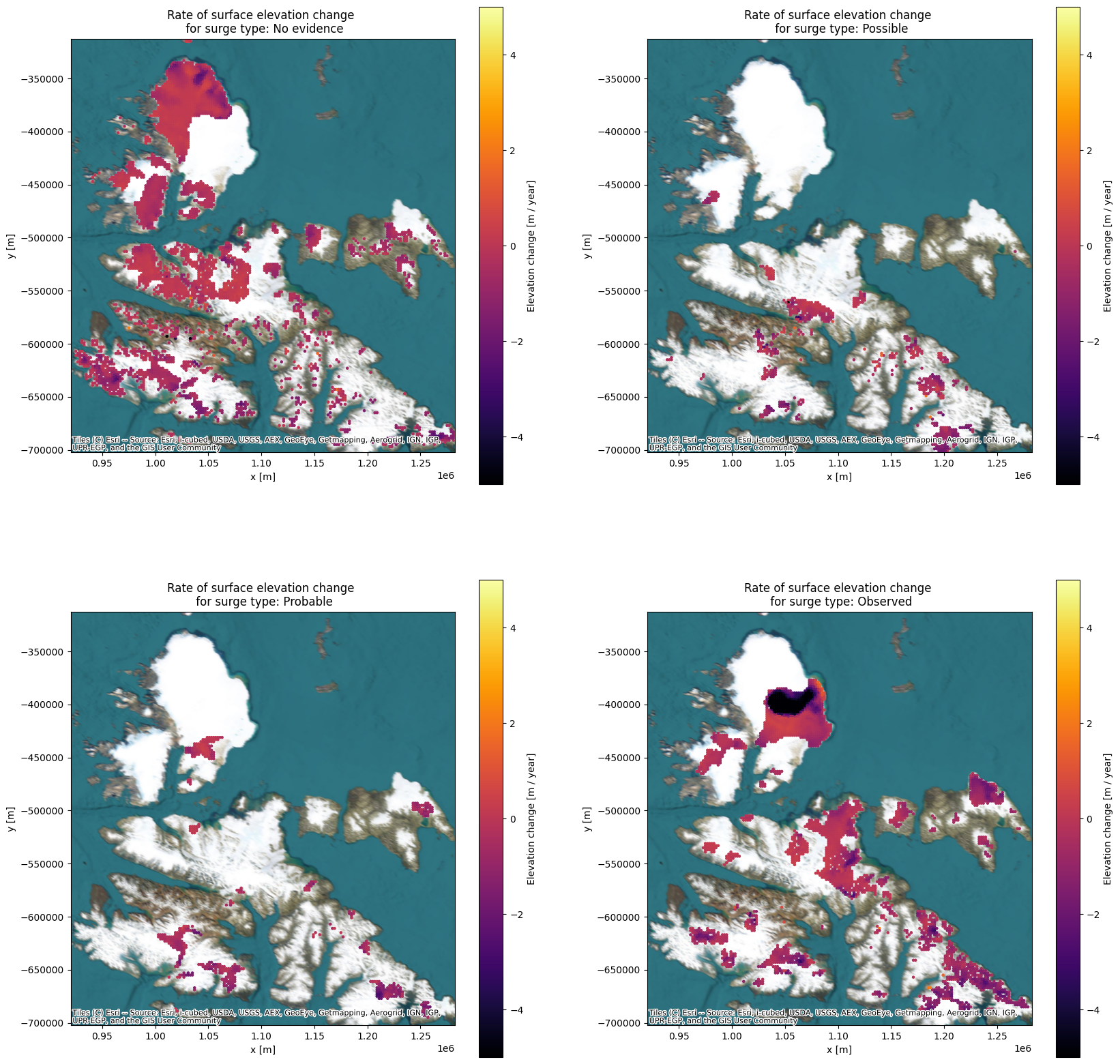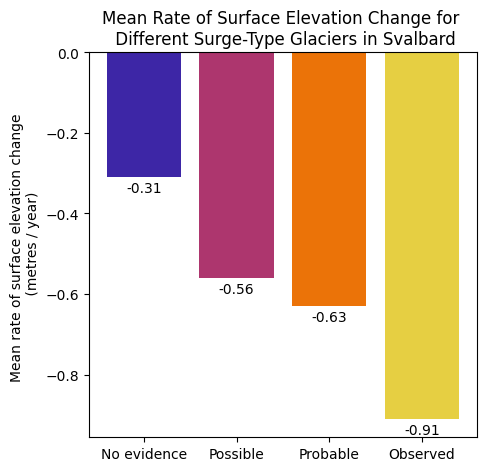CryoTEMPO-EOLIS Gridded Product & RGI: Comparing Elevation Changes of Surging and Non-Surging Glaciers in Svalbard
Introduction
This example retrieves CryoTEMPO-EOLIS Gridded Product data over 12 years using the RGI v7.0 glacier boundary definitions, and analyses the elevation changes for different surge-type glaciers across Svalbard.
You can view the code below or click here to run it yourself in Google Colab!
Environment Setup
To run this notebook, you will need to make sure that the folllowing packages are installed in your python environment (all can be installed via pip/conda):
matplotlib
geopandas
contextily
ipykernel
shapely
specklia
If you are using the Google Colab environment, these packages will be installed in the next cell. Please note this step may take a few minutes.
[1]:
import sys
if "google.colab" in sys.modules:
%pip install rasterio --no-binary rasterio
%pip install specklia
%pip install matplotlib
%pip install geopandas
%pip install contextily
%pip install shapely
%pip install python-dotenv
Query RGI polygons
Firstly, let’s use Specklia to retrieve the RGI polygons for glaciers in Svalbard.
[3]:
svalbard_polygon = shapely.Polygon(([3.9, 79.88], [28.6, 80.97], [28.6, 77.03], [14.57, 75.51], [3.9, 79.88]))
available_datasets = client.list_datasets()
rgiv7_dataset = available_datasets[available_datasets["dataset_name"] == "RGIv7 Glaciers"].iloc[0]
rgi_data, rgi_data_sources = client.query_dataset(
dataset_id=rgiv7_dataset["dataset_id"],
epsg4326_polygon=svalbard_polygon,
min_datetime=rgiv7_dataset["min_timestamp"] - Timedelta(seconds=1),
max_datetime=rgiv7_dataset["max_timestamp"] + Timedelta(seconds=1),
)
The RGI dataset provides a surge_type attribute categorising each glacier based on evidence of surging. Surging is typically short-lived events where a glacier moves many times its normal rate.
From the RGI v7.0 user guide we get the surge_type definitions:
[4]:
surge_type_definitions = {0: "No evidence", 1: "Possible", 2: "Probable", 3: "Observed", 9: "Not assigned"}
We can now plot the glacier boundaries on a map and colour code them by surge-type to see where they are.
[5]:
fig, ax = plt.subplots(figsize=(10, 10))
legend_elements = []
glacier_polygons = {}
for i, (surge_id, surge_type) in enumerate(surge_type_definitions.items()):
# we use a simplified version of the RGI polygons, which has a reduced number of vertices
polygons_for_surge_type = gpd.GeoSeries(
rgi_data[rgi_data.surge_type == surge_id]["simplified_polygons_t200"], crs=rgi_data.crs
)
if not polygons_for_surge_type.empty:
glacier_polygons[surge_type] = polygons_for_surge_type
color = cm.CMRmap((i + 1) / (len(surge_type_definitions)))
polygons_for_surge_type.to_crs(nps_epsg_code).plot(ax=ax, facecolor=color, edgecolor=color, alpha=0.5)
legend_elements.append(
Patch(facecolor=color, edgecolor=color, label=surge_type + f" ({len(polygons_for_surge_type)})", alpha=0.5)
)
ax.set_xlabel("x [m]")
ax.set_ylabel("y [m]")
ax.legend(handles=legend_elements, loc="upper right", title="Surge type (count)")
ctx.add_basemap(ax, source=ctx.providers.Esri.WorldImagery, crs=nps_epsg_code, zoom=6)
plt.show()

Query data for each surge-type category
Now that we have the glacier boundary definitions for each surge-type we can query the CryoTEMPO-EOLIS gridded dataset.
[6]:
svalbard_eolis_data = {}
svalbard_data_sources = {}
dataset_name = "CryoTEMPO-EOLIS Gridded Product"
gridded_product_dataset = available_datasets[available_datasets["dataset_name"] == dataset_name].iloc[0]
for _, surge_type in surge_type_definitions.items():
if surge_type not in glacier_polygons:
print(f"No data to query as there are no glaciers of surge type: {surge_type}, skipping..")
continue
query_polygon = glacier_polygons[surge_type].unary_union
query_start_time = perf_counter()
svalbard_eolis_data[surge_type], svalbard_data_sources[surge_type] = client.query_dataset(
dataset_id=gridded_product_dataset["dataset_id"],
epsg4326_polygon=query_polygon,
min_datetime=datetime(2011, 1, 1),
max_datetime=datetime(2023, 11, 1),
columns_to_return=["timestamp", "elevation", "uncertainty"],
)
print(
f"Query of glaciers of surge type: {surge_type} complete in "
f"{perf_counter() - query_start_time:.2f} seconds, "
f"{len(svalbard_eolis_data[surge_type])} points returned, "
f"drawn from {len(svalbard_data_sources[surge_type])} original sources."
)
/tmp/ipykernel_929/1037814231.py:11: DeprecationWarning: The 'unary_union' attribute is deprecated, use the 'union_all()' method instead.
query_polygon = glacier_polygons[surge_type].unary_union
Query of glaciers of surge type: No evidence complete in 30.84 seconds, 528076 points returned, drawn from 154 original sources.
/tmp/ipykernel_929/1037814231.py:11: DeprecationWarning: The 'unary_union' attribute is deprecated, use the 'union_all()' method instead.
query_polygon = glacier_polygons[surge_type].unary_union
Query of glaciers of surge type: Possible complete in 8.63 seconds, 84104 points returned, drawn from 154 original sources.
/tmp/ipykernel_929/1037814231.py:11: DeprecationWarning: The 'unary_union' attribute is deprecated, use the 'union_all()' method instead.
query_polygon = glacier_polygons[surge_type].unary_union
Query of glaciers of surge type: Probable complete in 8.22 seconds, 75051 points returned, drawn from 154 original sources.
/tmp/ipykernel_929/1037814231.py:11: DeprecationWarning: The 'unary_union' attribute is deprecated, use the 'union_all()' method instead.
query_polygon = glacier_polygons[surge_type].unary_union
Query of glaciers of surge type: Observed complete in 24.35 seconds, 417317 points returned, drawn from 154 original sources.
No data to query as there are no glaciers of surge type: Not assigned, skipping..
Compare elevation change time series per surge-type
From the Gridded Product documentation, we know that it is generated at a monthly temporal resolution.
We can now construct a monthly cumulative elevation change timeseries for glaciers of each surge-type.
[7]:
def calculate_time_series(gridded_product_data: gpd.GeoDataFrame) -> Tuple[NDArray, NDArray, List[int]]:
"""
Calculate a weighted average elevation change per month and associated errors.
Weights are assigned using the CryoTEMPO-EOLIS gridded product uncertainty.
Parameters
----------
gridded_product_data : gpd.GeoDataFrame
CryoTEMPO-EOLIS gridded product data.
Returns
-------
Tuple[NDArray, NDArray, List[int]]
Weighted average elevation change elevation change per month, error on weighted average,
and dates of each timestep.
"""
unique_timestamps = sorted(gridded_product_data.timestamp.unique())
# elevation change is in reference to first gridded product
reference_dem = gridded_product_data[gridded_product_data.timestamp == unique_timestamps[0]]
# initialise empty lists for time series data
weighted_mean_timeseries = []
weighted_mean_errors = []
for unique_timestamp in unique_timestamps:
gridded_product_for_timestamp = gridded_product_data[gridded_product_data.timestamp == unique_timestamp]
merged_gdf = reference_dem.sjoin(df=gridded_product_for_timestamp, how="inner")
merged_gdf["elevation_difference"] = merged_gdf["elevation_right"] - merged_gdf["elevation_left"]
# combine uncertainties for elevation difference
merged_gdf["elevation_difference_unc"] = np.sqrt(
merged_gdf["uncertainty_right"] ** 2 + merged_gdf["uncertainty_left"] ** 2
)
# calculate average elevation change, weighted by measurement uncertainty
weighted_mean = np.sum(
merged_gdf["elevation_difference"] / merged_gdf["elevation_difference_unc"] ** 2
) / np.sum(1 / merged_gdf["elevation_difference_unc"] ** 2)
# calculate weighted average uncertainty
error = np.sqrt(1 / np.sum(1 / merged_gdf["elevation_difference_unc"] ** 2))
weighted_mean_timeseries.append(weighted_mean)
weighted_mean_errors.append(error)
dates = [datetime.fromtimestamp(ts) for ts in unique_timestamps]
return np.array(weighted_mean_timeseries), np.array(weighted_mean_errors), dates
Plotting this time series, we see how the glaciers that are known to surge, or possible surging glaciers, are reducing in elevation more than non-surging glaciers.
[8]:
fig, ax = plt.subplots(figsize=(10, 5))
for i, (surge_type, gridded_product_data) in enumerate(svalbard_eolis_data.items()):
# calculate time series for surge type
weighted_mean_timeseries, weighted_mean_errors, dates = calculate_time_series(gridded_product_data)
# plot time series
color = cm.CMRmap((i + 1) / (len(surge_type_definitions)))
ax.plot(dates, weighted_mean_timeseries, lw=1, label=surge_type, c=color)
ax.fill_between(
dates,
weighted_mean_timeseries - weighted_mean_errors,
weighted_mean_timeseries + weighted_mean_errors,
alpha=0.5,
color=color,
)
ax.set_xlabel("Date")
ax.set_ylabel("Cumulative Elevation Change [m]")
ax.legend(title="Surge type")
plt.show()

Map rate of surface elevation change
Finally, we can calculate the rate of surface elevation change per year by applying a least squares regression to all data points for each pixel.
We can plot this spatially for the different surge-types to see how the glacier elevation is changing across svalbard, and plot the mean rate of elevation change per surge-type.
[9]:
def calculate_rate_of_change_map(gridded_product_data: gpd.GeoDataFrame) -> gpd.GeoDataFrame:
"""
Apply least squares linear regression to each pixel through time.
Parameters
----------
gridded_product_data : gpd.GeoDataFrame
CryoTEMPO-EOLIS gridded product data.
Returns
-------
gpd.GeoDataFrame
Rate of surface elevation change per year per pixel.
"""
pixel_groups = gridded_product_data.groupby(by="geometry")
rate_of_surface_elevation_change_years = []
for _, pixel_group in pixel_groups:
pixel_group_df = pixel_group.sort_values(by="timestamp")
m, _ = np.linalg.lstsq(
np.vstack([pixel_group_df["timestamp"].to_numpy(), np.ones(len(pixel_group_df))]).T,
pixel_group_df.elevation.to_numpy(),
rcond=None,
)[0]
# m gives the rate of change of elevation in seconds, lets crudely convert it to
# years for a more meaningful value
rate_of_surface_elevation_change_years.append(m * 60 * 60 * 24 * 365)
dhdt_gdf = gpd.GeoDataFrame(
{"rate_of_surface_elevation_change_years": rate_of_surface_elevation_change_years},
geometry=[key for key, _ in pixel_groups],
crs=gridded_product_data.crs,
)
return dhdt_gdf
[10]:
fig, axes = plt.subplots(figsize=(20, 20), nrows=2, ncols=2)
axes = axes.flatten()
min_x, min_y, max_x, max_y = rgi_data.to_crs(nps_epsg_code).total_bounds
mean_rate_of_change_for_surge_types = []
for i, (surge_type, gridded_product_data) in enumerate(svalbard_eolis_data.items()):
# calculate rate of surface elevation change for pixel over time
dhdt_gdf = calculate_rate_of_change_map(gridded_product_data)
mean_rate_of_change_for_surge_types.append(dhdt_gdf["rate_of_surface_elevation_change_years"].mean())
# plot rate of surface elevation change on map
dhdt_gdf.to_crs(epsg=nps_epsg_code).plot(
ax=axes[i],
column="rate_of_surface_elevation_change_years",
s=5,
cmap="inferno",
vmin=-5,
vmax=5,
legend=True,
legend_kwds={"label": "Elevation change [m / year]"},
)
axes[i].set_xlim(min_x, max_x)
axes[i].set_ylim(min_y, max_y)
axes[i].set_xlabel("x [m]")
axes[i].set_ylabel("y [m]")
axes[i].set_title(f"Rate of surface elevation change \n for surge type: {surge_type}")
ctx.add_basemap(axes[i], source=ctx.providers.Esri.WorldImagery, crs=nps_epsg_code, zoom=6)
plt.show()

[11]:
fig, ax = plt.subplots(figsize=(5, 5))
# round mean rate of change to 2 decimal places
rects = ax.bar(
svalbard_eolis_data.keys(),
[round(mean_rate, 2) for mean_rate in mean_rate_of_change_for_surge_types],
color=[cm.CMRmap((i + 1) / (len(surge_type_definitions))) for i in range(len(svalbard_eolis_data))],
)
ax.bar_label(rects, padding=3)
plt.ylabel("Mean rate of surface elevation change \n (metres / year)")
plt.title("Mean Rate of Surface Elevation Change for \n Different Surge-Type Glaciers in Svalbard")
plt.show()
